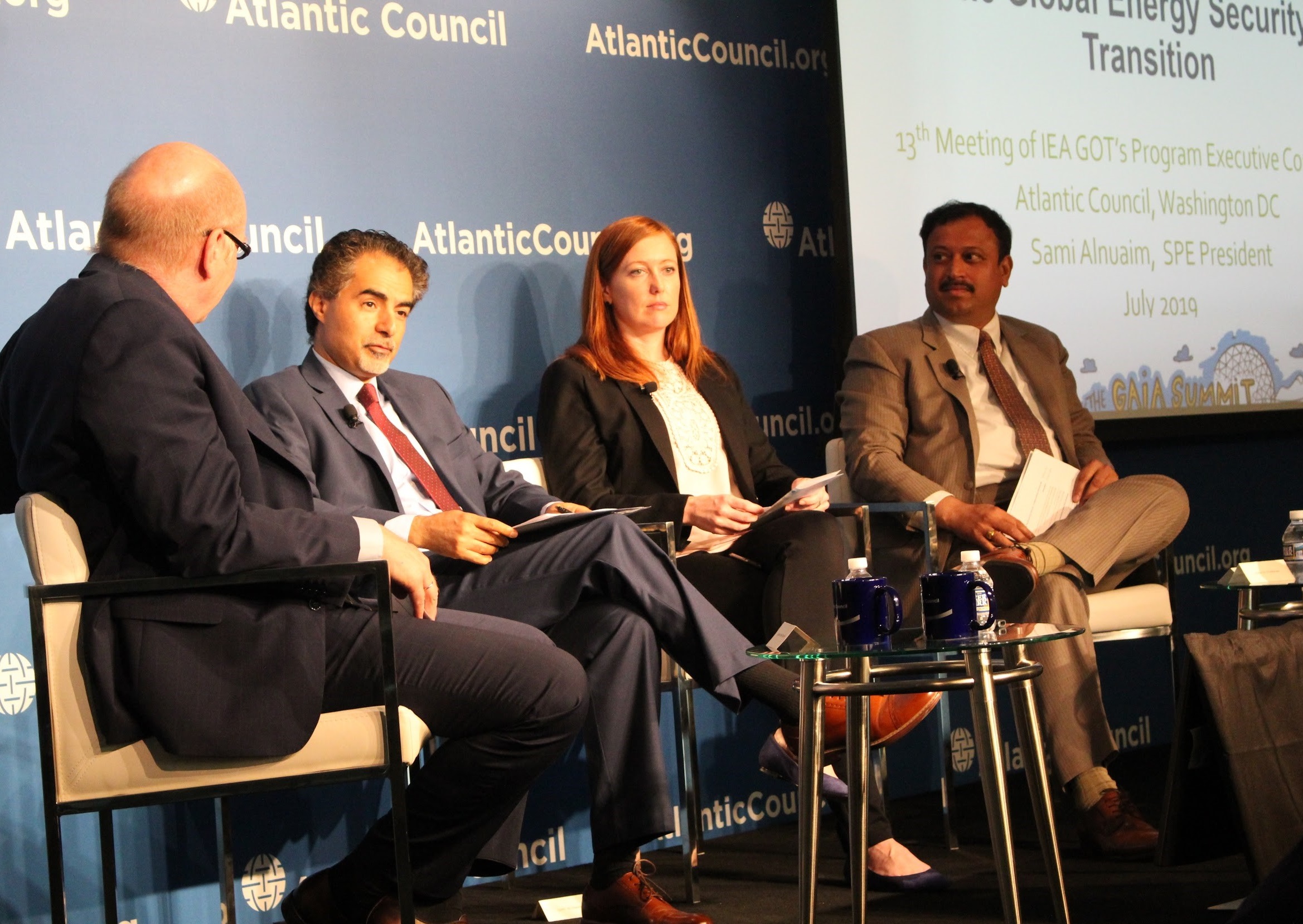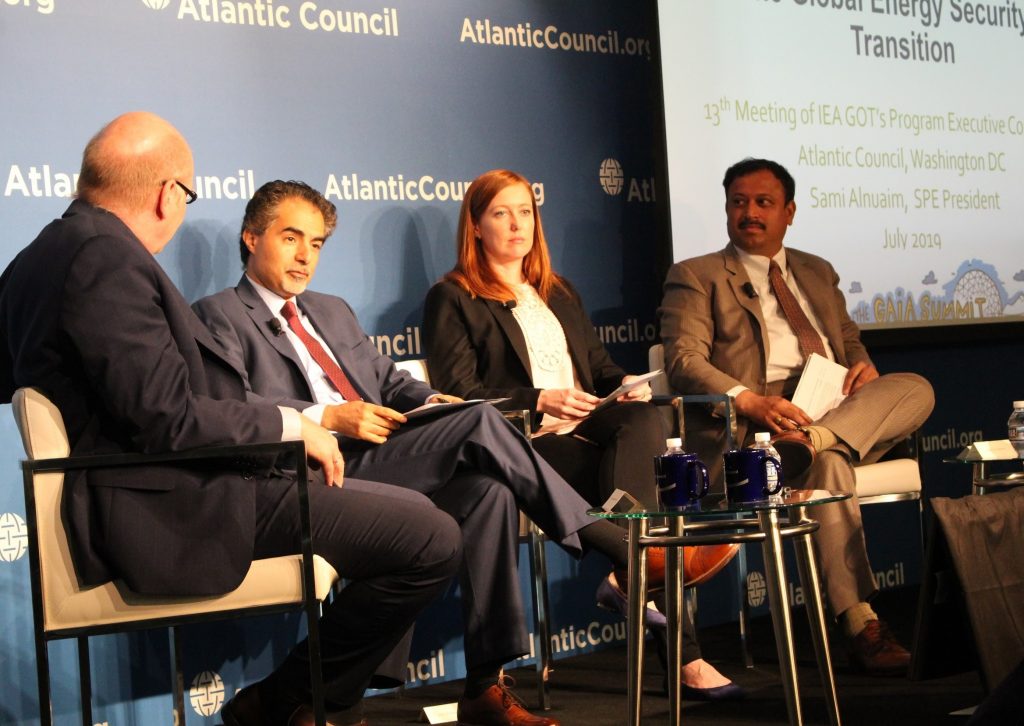
Day 1
On July 8 and 9, 2019, the Atlantic Council Global Energy Center hosted the 13th Meeting of the International Energy Agency’s Gas & Oil Technology Collaboration Program Executive Committee, bringing together energy policy experts from across the world. The first day of the event consisted of two panels: “Addressing Energy System Choices and Responses: The Case of India,” and “Next Generation Energy Investment—the Case of the Oil and Gas Sector.” Jostein Dahl Karlsen, president and chief executive officer of the International Energy Agency Gas and Oil Technology Collaboration Program, offered introductory remarks stressing assistance to nations for their energy choices, drivers of the energy transition, and the importance of resolving energy affordability and accessibility issues.
He then welcomed Shawn Bennett, deputy assistant secretary for oil and natural gas at the US Department of Energy (DOE), whose remarks highlighted the vastness of the oil and gas resources in the United States. Bennett specifically spoke about the progress the United States has made in oil and gas production since the beginning of the century. He also commented on the fact that US liquefied natural gas (LNG) exports play an important role in the energy security of other nations, especially given the freedom of exporting that US natural gas projects have. He stressed the fact that DOE is partnering with academia in order to perform necessary research on new applications, data analytics, and machine handling for the transition to non-conventional energy sources.
After Bennett’s remarks, the first panel, focusing on Indian energy system choices and moderated by Karlsen, began. Panelists included Nilkanth Avhad, economic counsellor at the Embassy of India; Lauren Diekman, senior director for energy, environment, and infrastructure at the US-India Business Council; and Sami Al-Nuaim, president of the Society of Petroleum Engineers.
Every panelist started the conversation with their respective opening remarks. Avhad mentioned that achieving energy growth in India is key to increasing gross domestic product (GDP) per capita in the country. Diekman stressed both that India is projected to account for a quarter of global energy growth for the next two decades and the importance of the mutually beneficial energy cooperation between the United States and India. Al-Nuaim noted that while oil and gas will remain an integral part of the energy mix for a long time, it will be crucial to make these sources cleaner. He also said that increased use of natural gas, more renewables in the power generation, and an increased use of non-combusted oil are all essential in the path towards reducing carbon emissions.
Karlsen began the panel discussion by asking Avhad about India’s role in the international energy market’s aim to improve people’s living standards. Avhad stated that India is currently approaching energy source diversification by putting more effort into renewable energy power generation. Al-Nuaim added to the response by praising India’s effort to get more gas into the country, which currently stands at only 7 percent of its energy mix, and Avhad commented on India’s progress on its Sustainable Development Goals, stressing that over 50 million people in the country got access to cooking gas, to use instead of highly harmful cooking fuel. He also touched on India’s goal of making seven thousand public transport buses go electric in the next three years. Jostein then turned to Diekman and asked her about the focus of the US Chamber of Commerce, specifically in regard to Sustainable Development Goals, and she commented that the commercial side of India’s energy market is concerned with pollution and the purity of the energy mix, which makes it a big part of their agenda.
Karlsen then switched the focus to Africa, asking Al-Nuaim if the same agenda applies there. Al-Nuaim stressed that the enormous predicted population growth for the region, as well as their current lag in energy access, calls for a more focused approach to Africa at the Society of Petroleum Engineers, including the importance of developing younger generations of African leaders in the oil and gas domain.
Karlsen then returned to the focus to India, asking Avhad about the extent of the country’s openness to foreign investment, as well as the state of their energy infrastructure. Avhad discussed India’s focus on attracting investment for renewable energy sources, particularly solar. In regard to India’s energy infrastructure, he outlined their plan to build LNG terminals on the east coast of the country, which would also benefit countries like Bangladesh.
Next Generation Energy Investment—the Case of the Oil and Gas Sector
Following a brief intermission, Al-Nuaim gave a presentation about the Society of Petroleum Engineers (SPE) and their plans to address the growing challenge of climate change through their Gaia program. Gaia is SPE’s plan to reorient the fossil fuel industry toward climate action—to shift the industry from contributing to climate change to leading in cutting emissions, including through industry adoption of sustainable development goals. He also detailed SPE’s efforts to work with governments and academia to encourage environmental stewardship in the industry, based on standardized measurements. He stressed the importance of both improving energy efficiency and carbon capture technology and of decreasing gas flaring.
After Al-Nuaim’s talk, the second panel of the day, covering oil and gas sector investment in the energy transition, convened. Melanie Kenderdine, senior fellow with the Atlantic Council Global Energy Center and principal at the Energy Futures Initiative, moderated the discussion with panelists Steinar Eikaas, head of low carbon solutions at Equinor, and Todd Glass, partner for energy and infrastructure at Wilson Sonsini Goodrich and Rosati. Kenderdine set the tone for the conversation with a brief presentation, focusing in particular how hydrocarbon producers can adjust their investments as climate action becomes increasingly urgent. She identified urbanization, digitalization, and the need for decarbonization as the defining trends of the energy transition moving forward. Eikaas also gave a brief introduction, covering Equinor’s low carbon efforts so far, including a major carbon capture and storage investment in the North Sea, a clean hydrogen fuel project in the United Kingdom, and a hydrogen to power and hydrogen storage program. Glass also gave brief opening remarks and stressed how renewables have changed the energy market landscape, particularly in driving down marginal power costs and rendering nuclear, coal, and inefficient natural gas plants economically obsolete. He also stressed that the oil and gas industry is uniquely situated to shape the future of energy because it has a long-term view of investment, an understanding of energy markets and systems, and has historically embraced competition.

Following the panelists’ opening remarks, Kenderdine asked a series of discussion questions about the role of carbon capture in the energy transition and Equinor’s experience in the sector, how solar tariffs and other policies affect investment, and the future of hydrogen fuel in the United States. Eikaas commented on Equinor’s commitment to carbon capture, utilization, and storage (CCUS) and stressed that current efforts are significant but not sufficient—regulatory and financial support are required to encourage CCUS implementation. Glass mentioned the 45Q carbon capture tax incentive law in the United States and agreed that policy support for carbon capture is necessary. While discussing solar tariffs, Glass said that tariffs had a very negative effect on the United States solar industry and that uncertainty, more broadly, on the future of US solar policy discouraged investment. On hydrogen fuel, Eikaas said that sectors that can electrify, should—including automobiles. But, he clarified that heavy sectors which cannot easily electrify should shift toward hydrogen fuel because it is a relatively simple substitute for natural gas.
Glass also spoke about regulation of the power industry, and argued that deregulation of the grid is not necessary, but deregulation of power generation could incentivize more production and help to quickly add more capacity. On critical minerals, both panelists agreed that focusing on supply chains is essential to avoid both conflict and potential monopolies. Glass also said that we should not be completely dependent on one solution, and that diversity of dependence will reduce the risk of being victim to a cartel. Finally, Eikaas said that Equinor is looking to clean its hydrocarbon use out to 2035—he indicated that he does not see the need to eliminate hydrocarbons completely, particularly because carbon capture can significantly reduce emissions. Glass agreed that hydrocarbons will not be phased out in the short term.
Kenderdine then opened up to audience questions, which covered the sustainability of the current renewable financing models given the low interest rates in the markets and the impact of California’s low carbon standard. Both panelists agreed that policy would determine renewable power business models moving forward because incentives could stimulate development even if interest rates go up And that carbon pricing could put a premium on renewable technology.
To watch the webcast of the second day of the conference, check out the webcast here.
Day 2
Energy Transition and the Global Energy Value Chain
Day two of the conference started with a panel on the energy transition and global energy value chain. This panel, moderated by Randolph Bell, director of the Atlantic Council Global Energy Center, included Andy Geissbuehler, advisory director at BVG Associates and country manager renewables US for the Norwegian Energy Partners/IEA GOTCP; James McCall, member of the Resources and Sustainability Group, Strategic Energy Analysis Center, National Renewable Energy Laboratory at the US Department of Energy; and Mary Rose de Valladares, general manager of the IEA Hydrogen Technology Collaboration Program.
The panel kicked off with introductory remarks by each speaker. Geissbuehler offered an offshore perspective on wind energy infrastructure investment. The four main drivers for the energy transition, according to Geissbuehler, are: wind resources, energy pricing, infrastructure and supply chain, as well as policy and stakeholder support. Karlsen then brought up projections of offshore wind performance past 2030, the timeframe Geissbuehler outlined during his presentation. He noted that cost erosion will occur in the wind power market, and regions beyond Europe will be able to fully benefit from the development of this renewable energy source. A question from the audience followed, inquiring about diminishing levels of risk in offshore wind investment. Geissbuehler responded, saying that risk levels are indeed very high, but he predicts that, with the development of the market as a whole, risk will be decreasing. The expansion of markets and the addition of new technology to the currently limited infrastructure creates an artificial level of risk, according to Geissbuehler.
Bell then welcomed McCall to offer his introductory points. McCall stressed the importance of matching the energy profile of drilling and completion of an oil well with the production that comes right after. At oil and gas well sites, there are also a number of other resources, such as geothermal energy, hydrogen, and processed heat. The main question is how a company decides to integrate and utilize these alternative energy resources on site, says McCall.
Bell then asked about the success of CO2 emission reductions at oil wells, and the possibility of further reductions if more companies were to effectively use renewable energy in the process. McCall stressed that there can be significant reductions in electricity use on site, for instance if the company uses solar energy in its operations. He also mentioned that California is able to cut oil and gas operation costs, due to its abundant solar resources, as well as their current cap and trade policies. An audience member asked about specific projects in Texas and California that made significant progress in the use of renewable energy in their operations and McCall highlighted California’s GlassPoint project, which is working in the Middle East to provide thermal energy in the region.
De Valladares then took the stage for her introductory remarks, which concentrated on the structure of the IEA Hydrogen Technology Collaboration Program, as well as several markets where hydrogen can be efficiently used. According to de Valladares, the transportation industry shows great promise for the application of hydrogen resources. Additionally, wind energy power generation and hydrogen production are showing great potential for sector coupling, which entails using one energy source to produce the other. Bell inquired about obstacles that hydrogen markets face in terms of delivery infrastructure, specifically that it will require a significant amount of CCUS. In response, de Valladares stressed the advantages that hydrogen has over electric vehicle batteries, such as not needing to invest in additional infrastructure to store energy at refueling stations. She also added that the logistics transportation vehicles market already sees hydrogen as a more efficient and profitable source. Bell then asked Geissbuehler if there is potential for wind energy market and hydrogen cooperation and Geissbuehler said that there are clear benefits in avoiding monoculture in energy markets and policy. He specifically named battery and grid storage as areas where cooperative solutions would be more beneficial and mentioned that hydrogen could solve one of the biggest challenges of offshore wind markets—connection points in the system—by making the grid independent.
Later, the audience raised questions about areas in the hydrogen value chain that require the greatest amount of research and development. De Valladares answered, saying that production and storage aspects need the most development at this stage of market development, because both of these areas could channel the idea of sector coupling. Another audience member asked Geissbuehler about the distribution of risk factors in wind energy market, specifically in storage. He responded that the majority of the risk is within the delivery stage of a project, due to the offshore environment, and stressed that hydrogen and offshore wind markets go hand in hand and could both boost their respective developments and accelerate the current transition of energy.
At the end of the panel, Bell switched the conversation to McCall, asking him how hydrogen is discussed in the oil industry. McCall said that hydrogen could be especially effective if used for backup generators at oil sites and mentioned that there are several examples of oil companies switching from diesel to hydrogen for their backup energy generation, allowing them to extend fuel storage periods.
Alternative Energy Investment: Regional Perspectives
Moderated by Atlantic Council Global Energy Center Associate Director Reed Blakemore, the second panel of the day covered regional perspectives on renewable and alternative energy investment and policies. Panelists included Vassilios Kougionas, policy officer in the European Union Commission DG Research and Gas & Oil Technologies Collaboration Program (GOTCP) ExCo delegate; Aubrey Hruby, senior fellow with the Atlantic Council Africa Center; and Ross Tyler, executive vice president of the Business Network for Offshore Wind.

Blakemore began by introducing each panelist in turn and priming each with a question for their opening remarks. Tyler summarized the state and outlook of offshore wind in the United States—though only 30 megawatts (MW) are currently operating, there is enormous projected growth, particularly along the East Coast, as the cost of offshore wind declines. Tyler also stressed the potential for oil and gas companies to contribute to the wind sector, especially with wind farms further off the coast. Blakemore asked how all the stakeholders, at both the state and federal levels, are working together and what needs to be done to both sustain current growth and encourage future growth in offshore wind. Tyler responded by stressing the importance of involving the public in offshore wind discussions to ensure general comfort with the industry, working with fishing communities to protect their industries, and communicating with environmental groups. He also touched on the need to work with policymakers on updating the grid to better handle the immense capacity growth promised by wind. Blakemore inquired about the United States’ position in the global offshore wind market and Tyler argued that US offshore wind resources offer fertile ground for European wind companies to branch out.
Kougionas offered his introductory remarks next, in which he gave an overview of the European Commission’s renewable targets and the current state of renewable investment in Europe. He stressed the need for not only wind and solar, but also hydrogen fuel and carbon capture to meet Europe’s climate goals. Blakemore asked Kougionas about the Commission’s efforts related to grid development and cross-border transmission in Europe to support increased electrification and Kougionas discussed the Commission’s work in constructing carbon dioxide and hydrogen pipelines between European states to encourage both hydrogen deployment and carbon capture measures. The audience asked Kougionas questions about the Commission’s investments in carbon utilization and how the Commission plans to make hydrogen prices competitive with natural gas, to which Kougionas responded that carbon utilization will make a contribution to reaching targets, but not as significant a contribution as simple capture, and that the plan for hydrogen is to increasingly use it in heavy industries, as renewable hydrogen is produced at a larger scale and thus becomes more economical.
The discussion then turned to Africa, and Hruby outlined opportunities and challenges facing the continent as it seeks to electrify and potentially take advantage of its immense renewable energy resources. She said that decarbonization is not a priority for most countries, as energy poverty is a more pressing concern and a lack of power is the biggest impediment to economic growth. Additionally, African distribution companies are largely bankrupt and need to improve their credit worthiness. She also outlined major business models on the continent as it continues to electrify, especially captive power to serve industry and off-grid renewable investment. Hruby also outlined the push toward LNG imports and gas-to-power to enhance electrification on the continent without turning to coal and commented that a major priority is reducing emissions from oil and gas assets, rather than diversifying into renewable investment, which is primarily entrepreneur-based. Hruby then took audience questions, beginning with the potential for renewable energy to take a lead in Africa. Hruby offered South Africa as a positive example, but stressed that other countries have not had the same political framework for that success—not because of companies are opposing renewables, but because of a current lack of political and knowledge capacity for renewables in countries with energy industries that are more experienced with carbon-based generation. Another audience member asked if Africa’s transmission and grid story would mirror that of the United States and what China was doing to build out renewables on the continent. Hruby said she believes that Africa will be unique because there the grid constrains energy production, rather than vice versa, and noted that China’s investments have primarily focused on transportation, rather than energy, and energy investments have been primarily focused on hydropower. Blakemore followed up by asking if there have been success stories in Africa that could be scaled to other countries on the continent, or that could provide lessons as other countries look to build out their grids or add renewables. Hruby mentioned sub-regional power pools as an example of scaled-up power sharing in Africa, as well as Kenya and Ethiopia’s power sharing agreements. She also discussed transportation in Africa, as automobile penetration increases and cities are clogged with traffic.
In the full panel discussion, Kougionas began by discussing the potential for the European Battery Alliance to take advantage of huge and growing battery storage demand in Africa. Hruby added that European countries and companies have led in some infrastructure investment in Africa, while solar panel and electric vehicle investments and imports have been led by Asia. Blakemore asked Tyler about the role hydrogen has to play in supporting offshore wind energy storage and Tyler responded by agreeing that hydrogen has a huge advantage in storing offshore wind energy, particularly for floating offshore wind—he particularly foresaw increased hydrogen demand in California as it expands its offshore wind capacity and seeks to become carbon neutral by 2050. Hruby added that hydrogen is a low priority in Africa because, in terms of renewables, solar is currently more attractive. On offshore wind, Tyler said that he believes Europe is far ahead of the United States in terms of technology, and that the United States will need to bring both government and private resources to bear in order to become a leader in floating offshore wind technology. The panel also took questions on the implication of critical mineral supply chains as renewable penetration increases, how African countries with large oil and gas discoveries can use those resources to power their own countries, and the role development organizations like the World Bank can play in easing an African energy transition.
Blakemore closed by thanking all the speakers from the event and expressing hope that the Atlantic Council and the IEA could work together again next year on the GOTCP event.
To watch the webcast of the second day of the conference, check out the webcast here.
